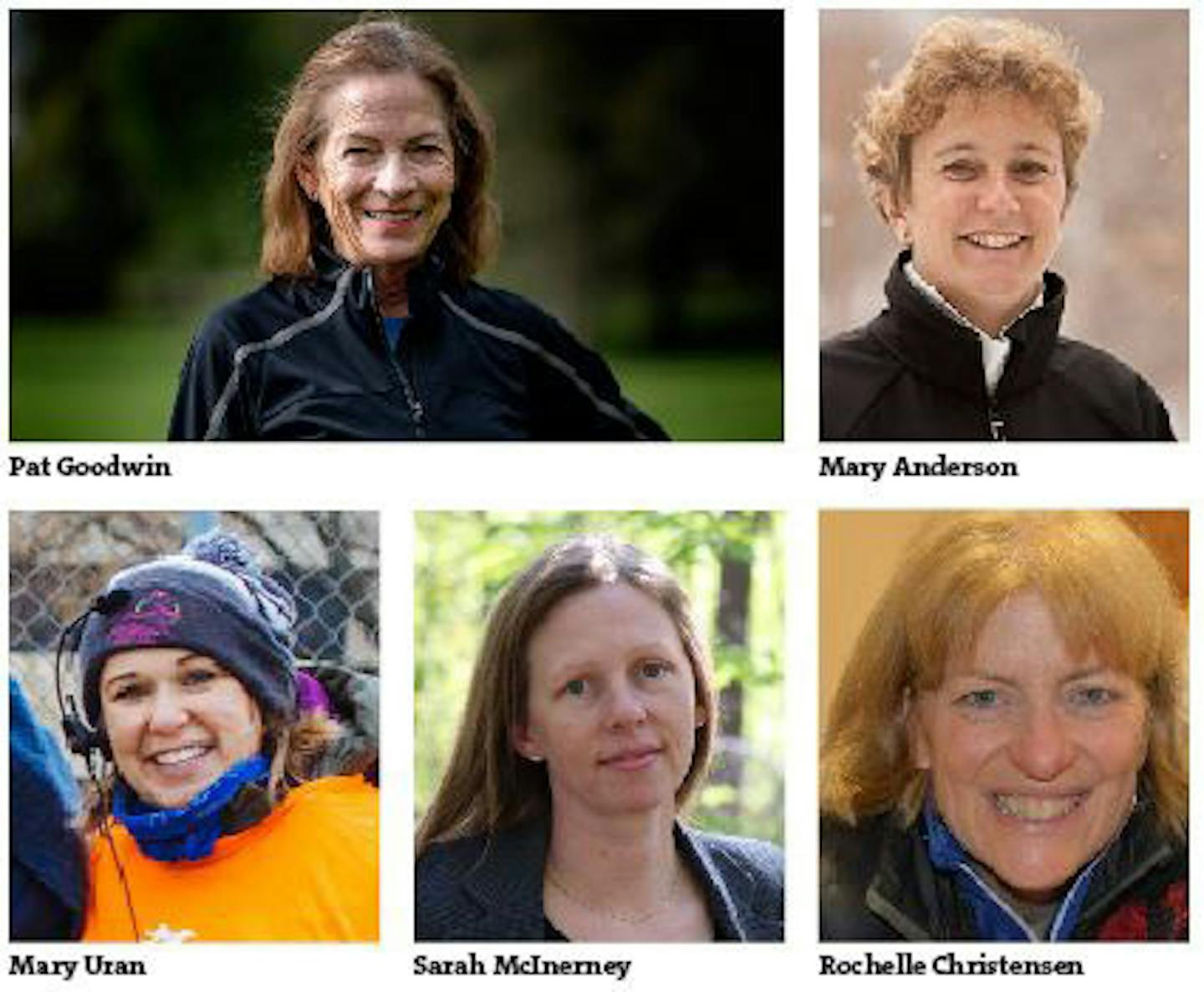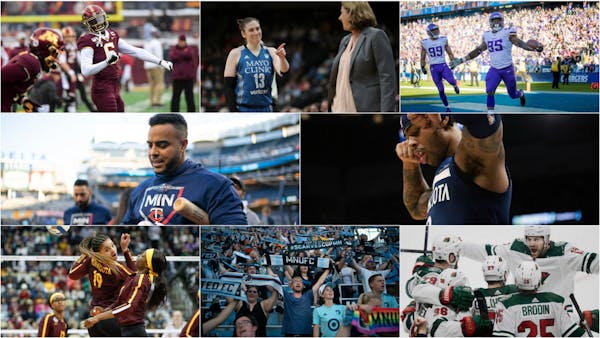There are 33 female chief executive officers on the Fortune 500 list. That's only 6.6 %.
The C-suite, which is the realm of chief officers, is similarly male-dominated in the business of sports. A handful of the 123 "big four" pro sports franchises are owned by women. Only about 40% of women's NCAA teams have female head coaches. Men's teams? Forget about it. Presidents, executive directors, owners? More than likely the person in the top spot is a man.
That is, unless you're talking about the business of running in Minnesota — race directors, CEOs, head coaches, retail owners, nonprofit founders. An exceptional number of women are in leadership positions. Shy of half, but more than 6.6 % for sure.
Why is that? Is it the culture of running? Or something about Minnesota, that so many women have stepped up and into the C-suite? Could these factors boost women's leadership in other sectors?
The takeaway after speaking with several leaders in the running industry is how much longer the list really is. Common to all — the women started out as runners. Participation in sports of any kind is just behind education in its ability to build leadership skills. Almost all female CEOs have participated in sports. As it happens, Minnesota was a hotbed of running in the 1960s, a community that was then almost all male. Today's bumper crop of female leaders were welcomed into the running world, even before Title IX.
"There were a bunch of really good guys who were not afraid of mentoring us," said Pat Goodwin, founder of Minnesota's first pro training group, Minnesota Distance Elite. "They were just pleased we were interested in the sport. A supportive male running community helped women get into leadership positions."
Goodwin, a public relations specialist, joined the all-male board of the Twin Cities Marathon, then became vice president, and in 1992, the first female president of the organization.
She credited Minnesota's egalitarian culture for fast-tracking women's sports, particularly running. Avon and Bonne Bell all-women's races, and Northern Lights, a women's running club that flourished in the 1980s and '90s, Goodwin said, helped women feel comfortable "out there in our shorts." Legitimate.
“Running isn't as gendered as other sports. Runners take that experience of equality with them out into the real world. When I was looking at coaching as a profession, gender was never an issue.”
In 2000, USA Track & Field announced funding for professional training groups.
"I thought, we're a hub of distance running; we gotta do this here," Goodwin said. "I'd managed my own business and had a lot of connections. And I didn't see anybody else stepping up."
She assembled a coach and a board and established Team USA Minnesota in 2001. The group recently changed its name to Minnesota Distance Elite. Unlike other all-male training groups at the time, the Minnesota group always has been half men, half women.
"I felt strongly about that. We modeled that gender mix on our board, too," Goodwin said.
In all distances short of the marathon, 60 % of the finishers are women. Mary Anderson, founder of Anderson Race Management, finds that stat telling.
"The increase in women in leadership roles is driven by increased participation. More female runners leads to more female directors — it's a natural progression."
That's Anderson's own story: an accountant with a running habit. When she wasn't running a race, she was volunteering. She nurtured her management company from side gig in 1996 to full-time business in 2007.
Right from the gun (the running boom of the late 1970s), Minnesota was at the forefront of women's running. Anderson mentioned Minnesota-made products such as the first all-women's marathon in the nation, Olympian Janis Klecker, and the Melpomene Institute For Women's Health Research, which is the only center of its kind in the country. Judy Lutter, a runner and researcher, kept getting calls from women who were, for the first time, training seriously, asking about menstrual cycles, osteoporosis, nutrition, pregnancy. In response, she established Melpomene in 1982.
Supportive and positive
Virginia Brophy Achman is probably the highest profile woman in Minnesota's running biz. Over the past 20 years with Twin Cities in Motion, she's been a volunteer, board member, race director, and now executive director. She's seen the organization grow from a single race to a health-and-wellness organization with a year-round slate of races and community programs.
Brophy Achman also has served with national running organizations and with local nonprofits. She's a master volunteer, networker, collaborator — leadership qualities often attributed to women.
"People like Pat [Goodwin] paved the way for other women in this industry," Brophy Achman said. "Our sport is uniquely supportive, rather than competitive. It's all about helping each other, regardless of gender."
Sarah Hopkins is young, 37. And she talks fast, so in the space of 30 seconds she reeled off how growing up in Minnesota helped her get where she is — head women's cross-country coach at the University of Minnesota, assistant in track. To summarize: a statewide progressive mind-set; acceptance of women in leadership roles; three Fortune 500 CEOs; Sen. Amy Klobuchar; and six running specialty stores of which two are husband-wife operations.
"Seeing women in those roles," Hopkins said, "it was ingrained — sure, why can't I have that job? Being able to see Pat and Virginia has been a big advantage for me."
Hopkins, like a lot of high school girls, ran with the boys. At road races, women were interspersed with men.
"Running isn't as gendered as other sports," Hopkins said. "Runners take that experience of equality with them out into the real world. When I was looking at coaching as a profession, gender was never an issue."
Except in a positive way. Hopkins said she's the first female coach most of her athletes have had. She lets them into her sometimes chaotic life as a mom to show them it's possible.
"It doesn't make them faster, but when they go out in the real world, they'll know they can do the job, as a mom with two little kids," she added.
The if-she-can-see-it-she-can-be-it message is enshrined in Girls On The Run's mission. Mary Uran thought if she was talking the talk (be bold, confident, a leader), she'd better walk it. In 2011, she established Girls On The Run Twin Cities, the local chapter of the national organization aimed at girls grades three through eight. The role was a leap from her job in public health policy to nonprofit executive director, but finding role models and advisers in the Twin Cities — that was the easy part.
"It's a pocket of progressive politics with major international companies and women in leadership," Uran said. Other features of the landscape that make Minnesota's running business woman-friendly? "There are safe and beautiful places to run, and we've had a lot of great female runners at all levels, like Carrie Tollefson [Tollefson is a GOTR coach]."
“There were a bunch of really good guys who were not afraid of mentoring us. They were just pleased we were interested in the sport. A supportive male running community helped women get into leadership positions.”
Setting the tone
Running in 1960 was an act of rebellion, practiced by unconventional free thinkers. As the state's first running organization, Minnesota Distance Running Association set the tone for an egalitarian culture. On paper, MDRA was founded by Pat Lanin in 1961, but Lanin is quick to say his wife, Emily, ran the show. She directed the Hopkins Raspberry Run that began in 1964, and put together the organization's magazine.
"In Minnesota, women were always involved in running. They weren't wives or secretaries, they were the actual people," said Sarah McInerney, who, together with president Rochelle Christensen, now head up the MDRA.
When Christensen, 61, went to college, women's career options were teacher or nurse. She spent 26 years as the director of employee benefits for the Evangelical Lutheran Church in America, competed in 27 marathons and a few triathlons, was diagnosed with leukemia, quit her job, and started a personal training business. Becoming president of MDRA was almost a responsibility.
"In 1961, women weren't doing that," she said. "Now they are. I felt having a woman president was important."
McInerney raced snowmobiles and motorcycles in high school in Duluth, organized a motocross group that raced internationally, and became a motorcycle referee (the only woman in that position in the U.S.).
"My family didn't adhere to gender roles," she said.
She found a similar sort of unaffected egalitarian attitude at MDRA. "The board paid me while I was on maternity leave. It was not even a discussion," McInerney said. "They're very progressive."
Whether it's something in Minnesota's water, or because running is, as sports go, gender-equal, there are a fair number of female leaders in the business of running. From these executives' experience, running is perfect leadership training for all fields.
Sarah Barker is a freelance writer. She lives in St. Paul.







